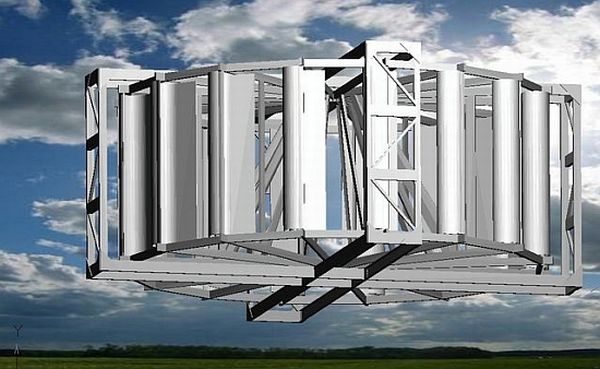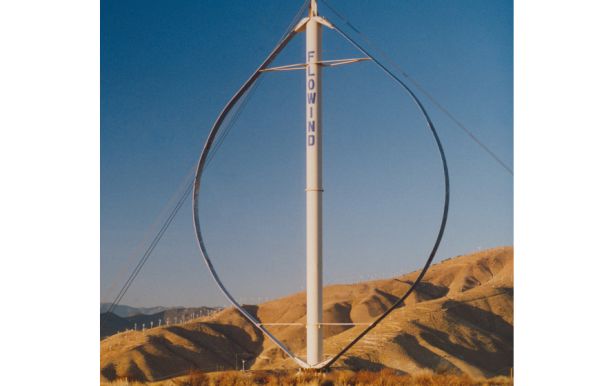
Vertical wind turbines look completely different from the conventional wind turbines that have blades rotating on the horizontal axis. The vertical turbine can be compared to a coin spinning on its vertical axis. Modifications in the design and structure have been done for improving the performance and serving more benefits. The major parts of the vertical wind turbine are a rotor shaft that is arranged vertically, a vertical wind generator located near the ground, a gearbox also located near the ground and the blades that are two or three in number. These wind turbines are being improved in terms of function and design for enjoying more advantages.
There are different types of vertical axis wind turbines such as;
Darrius turbine: Named after George Darrius, the French inventor. The turbine is known for its efficiency. However, it is criticized for the low torque. It requires an additional rotor to start it.
Gorlov Helical turbne: This turbine is designed in a helical configuration and was built to deal with the problems in the Darrius turbine. They are self-starting and reliable.
Giromill: It is a variation of Darius turbine. It offers high starting torque and variable pitch. The blades used in this type of turbines are curved, straight or v-shaped.
Savonius turbine: The turbine has helical scoops for providing smooth torque. Most of these are self-starting.
Apart from these there are many other types such as the neo-aerodynamic turbine, quiet revolution turbine, novel turbine and zephyr turbine.
The good

1. The energy generation with the vertical turbines cost is less and comes to about 2.5-3.5 cents for a kilowatt hour when compared to the 4-5 cents per kilowatt hour.
2. These turbines can handle high wind speeds. The maximum speed for harvesting the energy from wind is 28-33 mph. With the vertical design it can produce electricity from winds with a speed of 70 mph. The design can be used in areas with very strong winds.
3. One of the major problems with the conventional wind mills is that they kill the birds that come in their way. The design of the vertical turbine looks like a solid structure keeping the birds away from it.
4. The new device blends well with the environment. It can be painted in such a way that it blends well with the surroundings. Being smaller they can be installed in areas where huge structures cannot be used.
5. Another advantage is that the generator can be easily accessed for service. There is no magnetic field resonance, interference with communication or aircraft navigation and no ground resonance.
6. They function quietly too.
Can this be better?
The major difference between the vertical and horizontal wind turbines is the position of the blades. In the horizontal model the blades are mounted on the top while in the vertical model they are at the base of the tower and close to the shaft. The main advantage is that they can be mounted close to the ground making it beneficial for residential purposes.
The bad

1. When compared to the horizontal turbines, these vertical axis wind turbines are able to produce only about 50 percent of the energy.
2. Since no tower is required for the structure, they are not able to take advantage of the high wind speeds usually available on elevated and higher areas.
3. Some energy is required to start the device because of the low starting torque.
4. If any part of the device is damaged, the entire structure has to be disassembled for changing it.
5. Wires are required for holding the complete structure in place.
6. The vertical wind turbines have a complicated structure with high rate of failure.
7. Wind efficiency is low and costs higher.
Can this be avoided?
New designs of the vertical axis turbines are being made in order to deal with the problems faced by the earlier designs. More research and analysis is still required to develop a turbine without the above mentioned drawbacks.
The ugly

Though wind energy is considered to be one of the renewable and dependable sources of energy, there are several downsides to this.
1. Wind is not dependable. To turn the blades you need wind. If there is no wind they cannot function effectively. They are great only for areas where you can have wind all through the day and year. They may be useless in areas where wind is less.
2. One of the best places where you can get wind all through the year is the coastal areas, mountain tops and valleys. All these areas are very expensive and it can be very difficult to afford the area first and then build the turbine also.
3. Many people consider wind farms as an eyesore. Though they are able to produce energy using the wind, many people do not like the idea of residing near a wind farm.
4. Apart from that, the turbines are also known to interfere with the radio and television signals, kill birds and make noise.
Why are we so critical
Every new invention has its advantages and disadvantages. Similarly, the wind turbines faced some problems with respect to the availability of winds for turning the turbines, birds coming in between and so on. However, the researchers are trying to find solutions to each of these problems by creating new designs and using improved technologies. This gave rise to the vertical axis turbines. Though there are some negative aspects to this too, the researchers are striving hard to overcome them. Wind is everywhere. We need to make proper efforts to use it to the maximum in order to save other sources of energy and use the renewable sources in an effective way.
The bottom line
Wind energy is renewable. More and more devices have to be developed to harness the wind energy for generating electricity. The wind mills are efficient in generating energy. The type of turbines used depends on the area and the amount of power required in that particular area.




